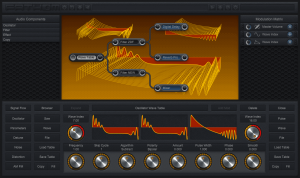
 Seaweed Audio has updated Fathom synth to version 2.19, which includes critical improvements in memory performance.
Seaweed Audio has updated Fathom synth to version 2.19, which includes critical improvements in memory performance.
Fathom's memory manager has been rewritten to load all GUI images just before each control becomes visible rather than when the plugin is opened. This reduces the total interface RAM from 650 MB to 250 MB.
The settings page can now be used to reduce oscillator sample buffer RAM from 1.00 GB to 0.15 GB.
Changes:
- Memory manager has been rewritten to reduce RAM to less than 50% of the previous size.
- GUI RAM reduced from 0.325 to 0.150 GB.
- Maximum Oscillator RAM reduced from 1.000 to 0.750 GB.
- Minimum Oscillator RAM reduced from 1.000 to 0.150 GB.
- Total RAM GUI normal reduced from 0.400 to 0.175 GB.
- Total RAM GUI resized reduced from 0.675 to 0.250 GB.
- Total RAM with minimum oscillator tables reduced from 1.600 GB to 0.360 GB.
- Changed the GUI so images are loaded just before windows are displayed rather than loading all images at start up. This reduces GUI memory on a new Fathom track from 0.325 to 0.150 GB.
- Changed the memory manager so that when the buffer size setting is changed it recalculates the oscillator buffers and reduces the total memory. The total amount of oscillator table memory changes from 1.000 to 0.150 GB.
- Fixed the envelope processor so that the smooth release of an interrupted envelope works correctly even if the release segment amplitude is zero. This covers the scenario where you want a note to decay to absolute zero if held past the decay phase but also the release to extend smoothly it the note is released before the end of the decay phase.
- Changed the LFO Easy and ADSR Easy modulation slat dials so that moving the mouse over the dial shows the dial name and value, not the target parameter. The target parameter is still shown if one of the controls is pressed or if the mouse moves over the edge of the modulation slat.
- Improved the ADSR Easy envelope so that the sustain segment keeps its shape even if the sustain level dial is moved. This allows the user to create a sustain segment with a different shape while keeping the ability to use the ADSR Easy dials using the new envelope shape.
- Increased the precision of all time period dials between the values of 0.5 and 1.0. These are the dials which display fractions 1/X for small values. In the range 0.5 to 1.0, instead of two wheel steps with a step value of 0.25, the range now has 16 wheel steps (0.03125) and 64 click steps.
- Fixed table reference bug in phaser effect which stopped the phase from oscillating if the mode was set to cycles and an oscillator is plugged into it.
- Changed the order of the top right shortcut buttons so they are symmetrical with the left side buttons.
- Eliminated time delay after dropping audio units into the signal flow view by letting the icon update and repaint before panels are created and oscillator buffers are calculated.
- Changed the signal flow path algorithm so that the connection path goes straight between units if they are on the same row and there is no unit between them.
- Fixed the polar morph filter expanded view so all graphics and points are positioned correctly when the GUI is resized.
- Changed the color selector slider colors slightly so the color numbers are always visible.
- Added a new processor setting "Modulate Period" which controls how timing is handled when the period of one modulator is modulated by another.
- Changed the Random Sample and Hold modulator so the random segments are aligned to the song when the host transport is started.
- Improved the timing of the Random Sample and Hold modulator when the speed dial is used so that the random segments are aligned to song beats provided that the speeds produced by the master envelope also align to beats.
- Changed all modulators to calculate using sample precision when the period is modulated instead of calculating the period timing once per block.
- Made the modulation processor smart enough to keep the correct LFO time if the period is modulated and the LFO is used to modulate multiple target parameters.
- Changed all modulation period calculations to double floating point so modulation of the period is accurate at both high and low LFO rates.
- Fixed the LFO period so that if it is modulated with a square wave or rectangular envelope the period remains aligned perfectly to the song position.

Find Fathom Synth in the KVR Marketplace



 Other Related News
Other Related News
